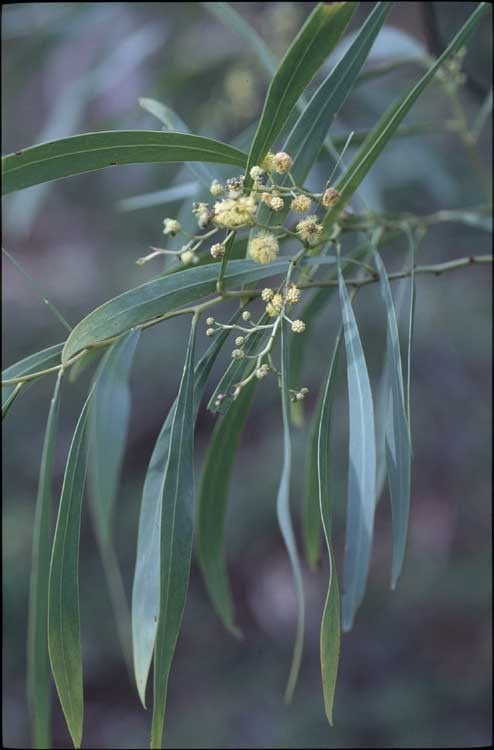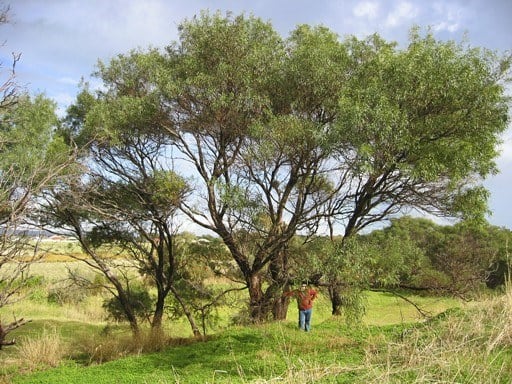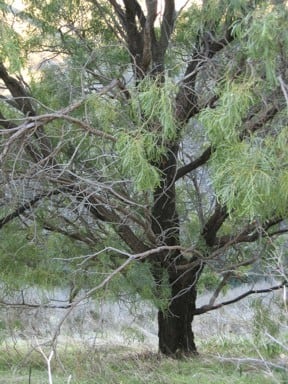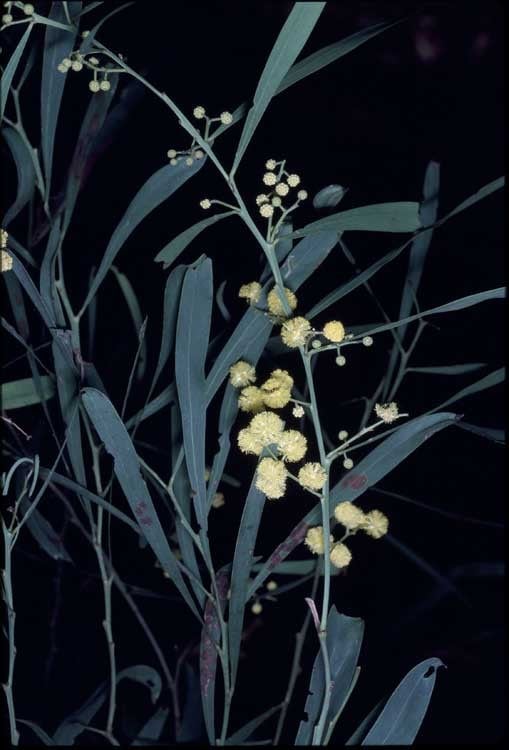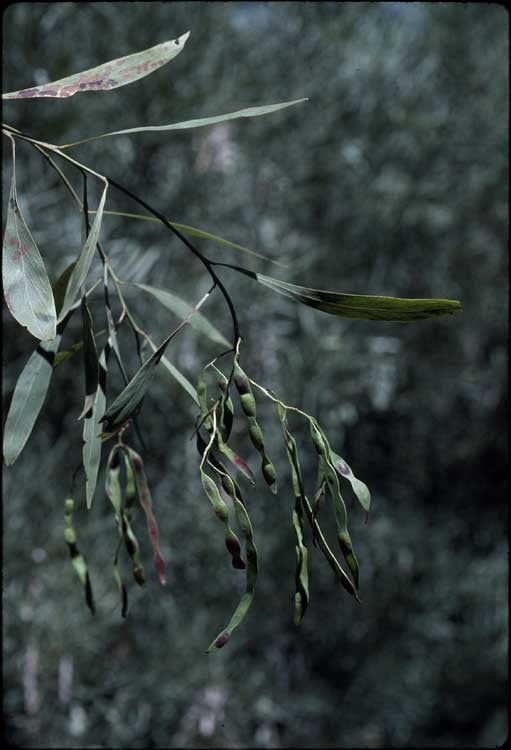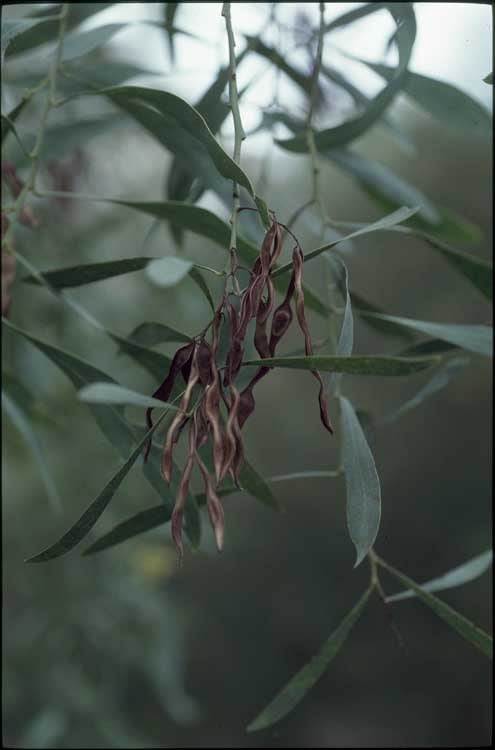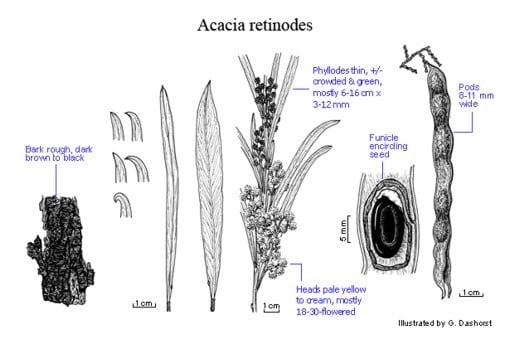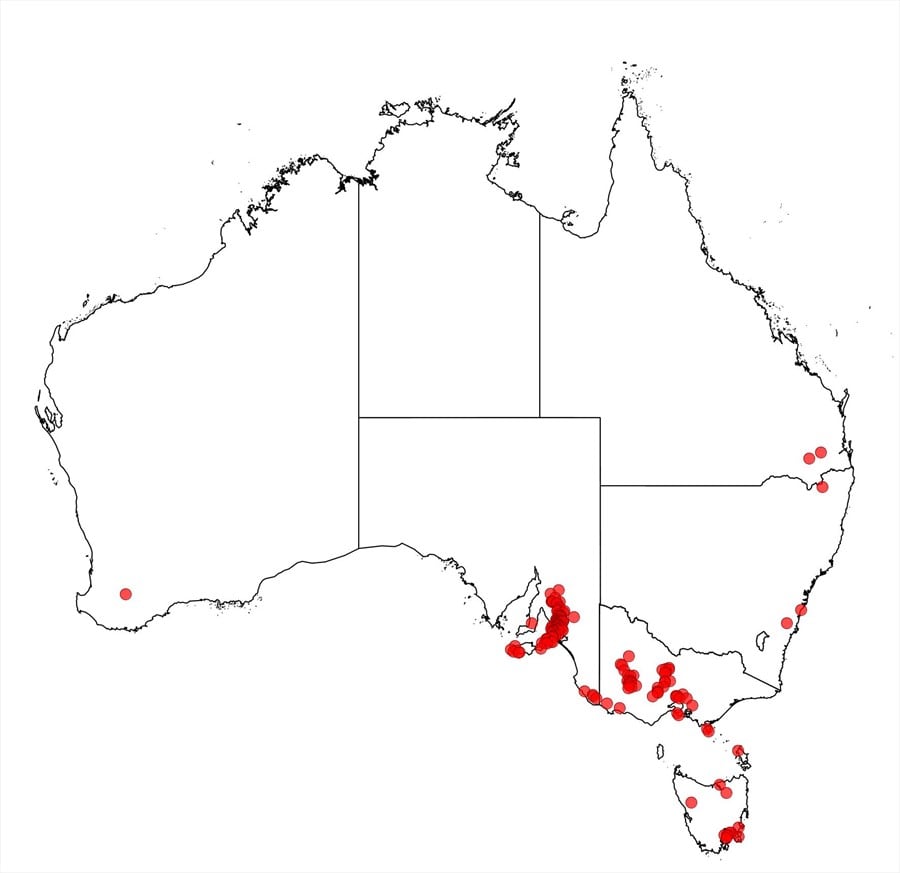Acacia retinodes Schltdl.
WATTLE
Acacias of Australia
Common Name
Wirilda, Hills Wirilda, Silver Wattle
Family
Fabaceae
Distribution
Endemic to the Mount Lofty Ra. from near Mt Bryan and Clare, S to Normanville and Delamere on the southern Fleurieu Penin., S.A. Also weedy in the extreme SE of the State.
Description
Tree to 10 m high, occasionally suckering. Bark rough, furrowed, dark brown to black. Branchlets occasionally pendulous, flattened or angular at extremities, glabrous. Phyllodes variable, crowded on stems (4–10 mm apart), oblanceolate to narrowly oblanceolate or linear, (5–) 6–16 cm long, (2–) 3–12 (–16) mm wide, acuminate, normally uncinate, green to grey-green, not pruinose, glabrous, 1-nerved per face, obscurely penninerved; gland small, 0–3(–7) mm above pulvinus. Inflorescences racemose; raceme axes 2–4 (–5) cm long; peduncles 3–6 mm long, slender, glabrous; heads globular, (16–) 18–30 (–34)-flowered, pale yellow to cream. Flowers 5‑merous; sepals united; ovary glabrous. Pods linear, to 16 cm long, 8–11 mm wide, firmly chartaceous. Seeds longitudinal, oblong to oblong-elliptic, 4–6 mm long, dark brown to black; funicle 3/4 or more encircling seed, red-brown to blackish; aril clavate.
Phenology
Flowers Dec.–Feb.
Habitat
Occurs on low hills and ranges in Eucalyptus woodland.
Specimens
S.A.: c. 2 km due NNE of Normanville Fleurieu Peninsula, B.R.Maslin 8355 (AD, CANB, PERTH); Mt Bryan, M.C.O’Leary 2729 (AD); Rockleigh, D.J.E.Whibley 5654 (AD).
Notes
Acacia retinodes is a member of the ‘Acacia microbotrya group’ most closely related to A. provincialis and A. uncifolia (see M.C.O’Leary, J. Adelaide Bot. Gard. 21: 97 Table 1 (2007), for differences); it is also related to A. confluens, A. leiophylla, A. rivalis and A. gillii. B.R.Maslin in Fl. Australia 11A: 282 (2001) noted that A. semiaurea is possibly a hybrid involving A. retinodes and either A. argyrophylla or A. dictyocarpa (which was treated as variant 2 of A. brachybotrya in that publication); this can not be confirmed, see M.O’Leary, J. Adelaide Bot. Gard. 21: 99 (2007), for further discussion.
Details of the breeding system are discussed in the papers of J.Kenrick & R.B.Knox, e.g. Theor. Appl. Genet. 69: 481–488 (1985). A widely cultivated, fast-growing but short-lived hardy species with unobtrusive flowers that occur sporadically throughout much of the year but with the main flush in spring and summer. Further information on the biological and ecological features, and the utilisation potential, of this species is given in B.R.Maslin and M.W.McDonald, AcaciaSearch: Evaluation of Acacia as a woody crop option for southern Australia, RIRDC Publication No. 03/017, 170–174 and 182–185 (2004).
In Fl. Australia 11B: 144 (2001) under Doubtful Names, B.R.Maslin considered that A. semperflorens Jacques might possibly be referable to A. retinodes. While M.C.O’Leary, J. Adelaide Bot. Gard. 21: 108 (2007), also regards this as a doubtful name he considers that the taxon is not referable to A. retinodes.
Plants from just S of Adelaide that B.R.Maslin & M.W.McDonald, loc. cit., treated as the Normanville variant of A. retinodes are now regarded as a coastal form of the species, fide M.C.O’Leary, J. Adelaide Bot. Gard. 21: 99 (2007).
The concept of A. retinodes by B.R.Maslin, Fl. Australia 11A: 281–283 (2001), was revised by M.C.O’Leary, J. Adelaide Bot. Gard. 21: 95–109 (2007): A. retinodes var. uncifolia is now treated as a distinct species, A. uncifolia, while A. retinodes var. retinodes is regarded as comprising two species, A. retinodes (from dry sites) and A. provincialis (from wetter sites).
FOA Reference
Data derived from Flora of Australia Volumes 11A (2001), 11B (2001) and 12 (1998), products of ABRS, ©Commonwealth of Australia
Author
Revised by B.R.Maslin & M.O'Leary
B.R.Maslin
This identification key and fact sheets are available as a mobile application:
URL: https://apps.lucidcentral.org/wattle/
© Copyright 2018. All rights reserved.
